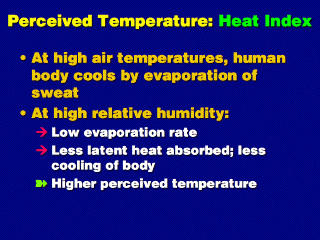When the air temperature is below
freezing (0°C), the wind chill equivalent temperature becomes important
to know for one's health, since the body heat loss at the lower perceived temperature
may be fairly large. While a windchill effect does occur at higher temperatures,
it is usuallly not significant for health reasons, since the lower perceived
temperature is in a safe range and the fact that the air temperature is closer
to body temperature causes the conductive heat loss to be much smaller, so there
is not much heat to convect away.
 But, at higher ambient air temperatures, you need to lose body heat in order
to not have an overly high body temperature, and because your body does not
lose enough heat by conduction to the air, you perspire and the evaporation
of the sweat increases body heat loss by absorption of latent heat. However,
at high relative humidities, the evaporation
rate may not be high enough to adequately cool the body. This leads to a higher
perceived temperature, since to you the smaller heat loss rate feels like a
higher ambient air temperature.
But, at higher ambient air temperatures, you need to lose body heat in order
to not have an overly high body temperature, and because your body does not
lose enough heat by conduction to the air, you perspire and the evaporation
of the sweat increases body heat loss by absorption of latent heat. However,
at high relative humidities, the evaporation
rate may not be high enough to adequately cool the body. This leads to a higher
perceived temperature, since to you the smaller heat loss rate feels like a
higher ambient air temperature.
The heat index is this perceived
temperature. As the relative humidity increases, the heat index increases for
a given ambient air temperature. At sufficiently high air temperature and humidity,
you can be susceptible to sunstroke or heat stroke, because the perceived temperature
may as well be the actual temperature as far as your body is concerned---if
it cannot get rid of the heat via evaporation of sweat, you will overheat.



 But, at higher ambient air temperatures, you need to lose body heat in order
to not have an overly high body temperature, and because your body does not
lose enough heat by conduction to the air, you perspire and the evaporation
of the sweat increases body heat loss by absorption of latent heat. However,
at high relative humidities, the evaporation
rate may not be high enough to adequately cool the body. This leads to a higher
perceived temperature, since to you the smaller heat loss rate feels like a
higher ambient air temperature.
But, at higher ambient air temperatures, you need to lose body heat in order
to not have an overly high body temperature, and because your body does not
lose enough heat by conduction to the air, you perspire and the evaporation
of the sweat increases body heat loss by absorption of latent heat. However,
at high relative humidities, the evaporation
rate may not be high enough to adequately cool the body. This leads to a higher
perceived temperature, since to you the smaller heat loss rate feels like a
higher ambient air temperature.